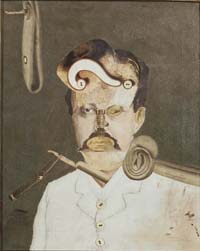The art movement known as Dada – or DADA! as some of the more emphatic Dadaists preferred to spell it – was so fluid that it baffled even its disciples. Like the sewing machine wrapped in a blanket and entitled The Enigma of Isidore Ducasse – a classic instance of Dada art created by Man Ray in 1918 – it remains a riddle wrapped in a mystery inside an enigma. A friendly wall-text at the entrance to “Dada”, the new exhibition at the Pompidou Centre in Paris, advises that bafflement or even disgust are perfectly appropriate responses. The stated aim of the show – unusual for a historical survey – is not to explain and inform but to puzzle and provoke. Visitors are encouraged to get lost. The experience is both entertaining and enlightening.
The word “Dada” is itself a model of tantalising impenetrability. The Zurich Dadaist Hans Richter assumed that it “had some connection with the joyous Slavonic affirmative, ‘Da, da’ … ‘Yes, yes’ to life”. But when the Berlin Dadaists wrote their manifesto they claimed that its overriding message was “NO! NO! NO!” – a resounding rejection of what they saw as the self-indulgent and inward-looking art of their expressionist predecessors. Likewise, no one knows exactly where Dada was born. Some say it happened in Switzerland, while others favour Germany. A strong case has also been made for New York, where, in 1917, the expatriate French artist Marcel Duchamp created the first of his so-called “readymades” by submitting a mass-produced porcelain urinal, entitled Fountain, to the Independents Exhibition. When this aesthetically subversive item was rejected by the hanging committee on the grounds that it was a piece of plumbing, not a work of art, Duchamp memorably replied that it was irrelevant whether he had actually “made the...

Dada at The Centre Pompidou
30-11-1999

